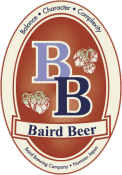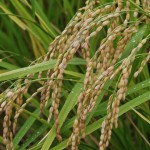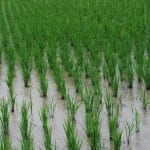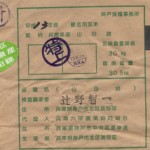Kuramoto, Toji and Kurabito
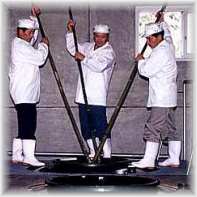
Men at Work at Rihaku Brewery
Sake is produced by the kuramoto (brewery owner), the toji (head sake brewer), and the kurabito (brewery workers). In economic terms, creating the product calls for land, finances and raw materials. The kuramoto is responsible for procuring these, while the toji is responsible for the actual brewing and the hiring and management of the kurabito. Moreover, since sake is brewed only in the winter, the toji and kurabito are essentially “contract” workers.
The Toji System
The toji, or head brewer, is generally associated with one ryuha, or “school” of brewing. These toji ryuha are tied closely to various regions throughout Japan, and there are perhaps 25 schools of toji in existence now. Each school has its own style, to be sure, and that style is evident in the sake they brew, but the differences between various schools of toji is not what it was long ago. Long ago, it was all quite secretive, and the methods employed and refined by one group were never disclosed to other groups. But, over the past several decades, toji and brewers from all over the country readily share information in their shared desire to make better sake.
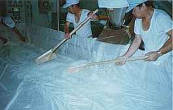 In part, the toji system came about with a little help from the government. In 1798 the Shogunate formalized an economic system based on rice. In order to establish tight control, the government decreed that no sake brewing was permitted before the Autumn Equinox. Although not much could be done in the warmer seasons anyway, sake brewers now had to go into the boonies to get the farmers who found themselves with too much free time in the winter.
In part, the toji system came about with a little help from the government. In 1798 the Shogunate formalized an economic system based on rice. In order to establish tight control, the government decreed that no sake brewing was permitted before the Autumn Equinox. Although not much could be done in the warmer seasons anyway, sake brewers now had to go into the boonies to get the farmers who found themselves with too much free time in the winter.
Toji for the most part are, in the off-season, farmers and fishermen. During the spring, summer and fall, they grow rice or work on fishing boats in their home regions. When the fall harvest is over, or the fishing season ends, there is no longer any work in their villages. This is the season when they head off to sake breweries to work. In Japanese, this traveling for seasonal employment is called “dekasegi.”
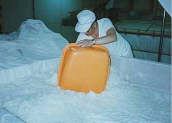 The various toji schools are usually centered in the snowy regions of Japan, like the northern Tohoku region and Hokuriku region. Although the dekasegi system of travelling far from home for seasonal work was never limited to the sake brewing industry, the pay and status of sake laborers was always relatively higher than other seasonal labor jobs. In general, the competition for jobs in the sake industry has thus been more intense than in other industries employing dekasegi laborers. For more on toji schools, click here.
The various toji schools are usually centered in the snowy regions of Japan, like the northern Tohoku region and Hokuriku region. Although the dekasegi system of travelling far from home for seasonal work was never limited to the sake brewing industry, the pay and status of sake laborers was always relatively higher than other seasonal labor jobs. In general, the competition for jobs in the sake industry has thus been more intense than in other industries employing dekasegi laborers. For more on toji schools, click here.
Learning the Trade
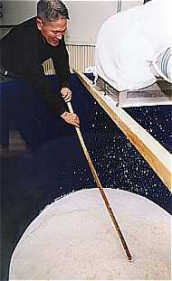
Doi fermentation tank
A toji basically learns his skill through on-the-job training. There are no texts, and the only way to learn is by watching. In the old days, no one taught anyone else by direct instruction; one was expected to watch and learn. This allowed one to develop a very deeply embedded and strong sense about what to do in each situation. As a result, if you gathered together 100 toji, you would likely find 100 different brewing styles. Indeed, the Japanese saying Sakaya Banryu was coined to express this wide divergence in toji styles.
In modern times, however, this system of learning only by watching has changed somewhat. Today, the government and toji unions encourage those wanting to become toji to formally study fermentation and chemistry.
A Typical Toji Work Day
What precisely does a toji do? Let’s look at a typical day during the high season of sake brewing. The toji, along with the other brewing craftsmen (kurabito), gets up about five in the morning. The first thing to do is to check on the state of the koji. Koji development is an extremely important step in the brewing process, in which the starch in the rice is converted into sugars. Koji is created by propagating koji mold spores (called aspergillus oryzae in English) onto rice. To do this properly, the koji must be mixed regularly and have its temperature checked constantly. This is the first order of business in the early morning.
 Next, toji check the status of the various tanks of fermenting sake mash. This mash, called moromi in Japanese, is a mixture of koji, rice, water, and yeast. The mash must undergo fermentation to yield alcohol, and the typical fermentation period lasts two to three weeks. However, premium ginjo-shu sake takes longer (usually one month) to ferment.
Next, toji check the status of the various tanks of fermenting sake mash. This mash, called moromi in Japanese, is a mixture of koji, rice, water, and yeast. The mash must undergo fermentation to yield alcohol, and the typical fermentation period lasts two to three weeks. However, premium ginjo-shu sake takes longer (usually one month) to ferment.
During the fermentation period, the toji will check daily the status of each moromi tank. This often means making a chemical analysis of the moromi to determine if various compounds are sufficiently present. But the toji does not rely purely on chemical analysis. He relies on his experience and 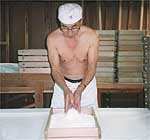 eyes to judge the condition of the mash. He looks at the foam on the surface of the moromi, how much carbon dioxide is emanating from it, the amount and appearance of the foam, and even the sound of the foam as it churns and bubbles pop. The toji call this “talking to the moromi.” It ‘s like judging a baby’s health by listening to the baby’s crying. Then, based on this information, adjustments are made.
eyes to judge the condition of the mash. He looks at the foam on the surface of the moromi, how much carbon dioxide is emanating from it, the amount and appearance of the foam, and even the sound of the foam as it churns and bubbles pop. The toji call this “talking to the moromi.” It ‘s like judging a baby’s health by listening to the baby’s crying. Then, based on this information, adjustments are made.
For example, if the yeast is particularly active and the fermentation is proceeding too quickly, he may cool the tank down a bit to slow the progress of the fermenting moromi. Just how many degrees it needs to be chilled would be a decision based on the toji’s experience. Before there were any major technological developments, sake was brewed exclusively by these kinds of methods, but even today in the age of chemical analysis and modern technology, these skills are just as important as the analysis and modern equipment.
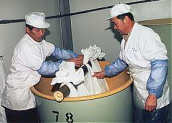 After checking on the moromi and koji, the toji eat breakfast. Following that, preparations are made for the sake that will be brewed that day. This includes washing rice, steaming large amounts of rice, cooling the rice after steaming, adding it to the correct fermenting tanks, and making koji.
After checking on the moromi and koji, the toji eat breakfast. Following that, preparations are made for the sake that will be brewed that day. This includes washing rice, steaming large amounts of rice, cooling the rice after steaming, adding it to the correct fermenting tanks, and making koji.
There are usually several types of sake being brewed at any one time, each calling for different types of sake rice. Toji must be very careful to keep their rices separate. Also, sake that has completed its fermentation period and is ready will be pressed to separate the clear sake from the remaining rice solids to give what is called genshu, or pure undiluted sake. This process can take all day and last into the evening.
After dinner, they take a break prior to the late-evening check and mixing of the koji. They go to sleep about ten o’clock, with the same work awaiting them the next morning.
Today, scientific theories and systematic testing provide viable explanations for the fermentation process, and the toji craft has lost some of its “magic and mystery.” Yet, we must still admire the toji, for they are dealing daily with a fermentation process that involves microorganisms too small to be seen by the naked eye. Some of these microscopic organisms are floating around in the air, and although some are beneficial to sake production, others are detrimental. Just how to balance the effects of these organisms is something the toji does not with his eyes, but based on his experience, his sense, and his intuition. And in the end a great toji creates a great work of art that science alone could never achieve through automation. Making sake is indeed deep and complicated work. It may seem that a toji’s work is one of simple repetition, but each day he works with nature, not against it, to seemingly control organisms he cannot see, based on what could be called “the eyes of his heart.”
Decline in Number of Toji
Along with a general decline in the number of sake breweries in Japan, the number of toji as well is declining owing to advanced age, the lack of successors, and the utilization of mass-production techniques. The average toji age is 65. Successors are hard to find, as more and more Japanese youth prefer the excitement and opportunites of the big cities to life in small farming and fishing villages. The toji take pride in their work, but they also know it is hard work on a seasonal basis and thus in general they refrain from forcing their children to follow in their footsteps.The number of toji is expected to decline rapidly in the years ahead, but some kuramoto are working to remedy this situation. Some are moving away from “contracted” seasonal labor and offering more permanent employment opportunities. Others are attempting to automate certain operations, like bottle transport, which do not require a “handmade” touch. Some are introducing computers and new technologies to “simulate” — via fuzzy logic — the experience and intuition of the toji. Although many smaller brewers are experimenting with ways to combine automation technologies with centuries-old hand-made brewing techniques, their objectives remain quite different from the large-scale mass producers of sake. The objective of the small brewer is not to produce greater volume, but rather to continue producing unique “hand-made” sake with technologies and employment practices that ensure its future survival.
Famous Toji Schools
There are about 25 toji ryuha throughout Japan. The largest three are by far Nanbu toji from Iwate, Echigo toji from Niigata, and Tajima toji from Hyogo. Their names come from the old geographical names for their respective regions. As might be expected, Nanbu toji were centered around Tohoku, Echigo toji near Niigata and Kanto, and Tajima toji in Nada and Fushimi. Other examples include Akitsu toji from Hiroshima, Yamanouchi toji from Akita, and Tanba toji, also from Hyogo.
Although consumer demand has often come to dictate style more than in the past, some semblance of regional distinction remains. Sake made by Echigo toji is quite often “tanrei karakuchi,” or dry and clean. The soft and mellow sake of Nada and Kyoto is indicative of that made by Tajima toji, and Nanbu toji sake is generally simple, straightforward, but well pronounced; a personal favorite as far as styles go. Others recommendable for their distinction and memorability include the sake of Hiroshima’s Akitsu toji, and that of the Izumo toji of Shimane, albeit a bit harder to find.
As the number of kura (sake breweries) has drastically declined, naturally so has the number of toji in most ryuha. The number of Echigo toji has dropped to one-third what it was at the beginning of the Showa era, and the number of Tajima toji, the largest at the beginning of the Showa era, has dropped to one-tenth the number of members. Only the Nanbu toji have retained strength in the ranks, having maintained the same number of members for the past 40 years or so. This may be due to the training and strict qualifications testing provided. Amongst prize-winning sake, the Nanbu toji names are appearing with increasing frequency.
With the convenience of modern transportation systems, the toji are venturing farther and farther from home. They very often travel together with the same crew of kurabito (workers). For example, Nanbu toji and their merry bands can be found as far south as Kansai. They have come to naturally fill the voids left by the decreasing number of Echigo toji.
As interest increases in the factors that go into brewing good sake, the name of the toji, and where he or she is from, is often listed on the label. Paying attention to toji helps develop a sense for the particular styles and distinctions of the various regions.
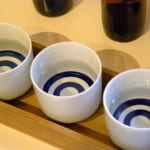 Some fairly significant alcohol tax changes are afoot in Japan. And they will benefit sake domestic consumers in a good way. Sure, the savings to us that result from these changes will be moderate. And in fact, they will likely be offset by inflation, especially since they will kick in slowly over the next few years. But still, we’ll take what we can get.
Some fairly significant alcohol tax changes are afoot in Japan. And they will benefit sake domestic consumers in a good way. Sure, the savings to us that result from these changes will be moderate. And in fact, they will likely be offset by inflation, especially since they will kick in slowly over the next few years. But still, we’ll take what we can get. On December 22nd of last year, there was a massive fire in the city of Itoigawa in Niigata Prefecture. In total, 144 buildings were damaged or destroyed. Miraculously, no one died, although 11 were injured. It was a reminder of just how devastating fire can be in small village towns comprised of many old wooden buildings.
On December 22nd of last year, there was a massive fire in the city of Itoigawa in Niigata Prefecture. In total, 144 buildings were damaged or destroyed. Miraculously, no one died, although 11 were injured. It was a reminder of just how devastating fire can be in small village towns comprised of many old wooden buildings.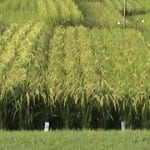 The rumor is that Yamada Nishiki rice is in excess these days.
The rumor is that Yamada Nishiki rice is in excess these days.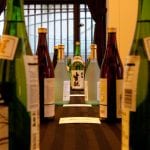 From Monday, April 3 until Wednesday April 5, I will hold the first Sake Professional Course of 2017 at Bentley Reserve in San Francisco. If interested, for more information please send me an email at sakeguy@gol.com. “No sake stone remains left unturned” in this very comprehensive course. Learn more here.
From Monday, April 3 until Wednesday April 5, I will hold the first Sake Professional Course of 2017 at Bentley Reserve in San Francisco. If interested, for more information please send me an email at sakeguy@gol.com. “No sake stone remains left unturned” in this very comprehensive course. Learn more here.




 The main raw materials of sake are rice and water, and rice is the only fermentable material used in its production. And just as the grapes used to make good wine are significantly different from those bought at the supermarket, the rice used to make premium sake is significantly different from that which we find sitting under the fish in sushi, or in bowls in meals.
The main raw materials of sake are rice and water, and rice is the only fermentable material used in its production. And just as the grapes used to make good wine are significantly different from those bought at the supermarket, the rice used to make premium sake is significantly different from that which we find sitting under the fish in sushi, or in bowls in meals. In proper sake rice, the higher-than-normal starch content is mostly concentrated in the center of the grains. Why is this so heart-warmingly special? Because we want to get at the starch, which will be converted to sugar and then into alcohol. But we don’t want the fat and protein, which would lead to off-flavors and contribute rough elements to the sake. So with the starch neatly concentrated in the center, all we need to do is to mill away more and more of the outside of the grain, and by doing that we remove the fat and protein and leave only the starchy goodies behind.
In proper sake rice, the higher-than-normal starch content is mostly concentrated in the center of the grains. Why is this so heart-warmingly special? Because we want to get at the starch, which will be converted to sugar and then into alcohol. But we don’t want the fat and protein, which would lead to off-flavors and contribute rough elements to the sake. So with the starch neatly concentrated in the center, all we need to do is to mill away more and more of the outside of the grain, and by doing that we remove the fat and protein and leave only the starchy goodies behind.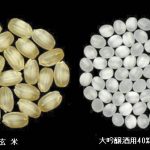 Why does sake rice have the starch in the center, and fat and protein around that? Part of it is just the nature of those strains. But it also has to do with climate and growing conditions. Regions with hot days and cold nights are best for sake rice production, as the cold nights coerce the plant to send the starch to the center of the grains. In “bad years” for rice, seasons being too hot or too cold, too wet or too dry, or when the night and day temperatures had less variance, fewer grains will have a decent shinpaku.
Why does sake rice have the starch in the center, and fat and protein around that? Part of it is just the nature of those strains. But it also has to do with climate and growing conditions. Regions with hot days and cold nights are best for sake rice production, as the cold nights coerce the plant to send the starch to the center of the grains. In “bad years” for rice, seasons being too hot or too cold, too wet or too dry, or when the night and day temperatures had less variance, fewer grains will have a decent shinpaku.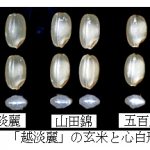 Note, too, that one can make decent-to-good sake from regular rice. It takes a good toji and good tools, but just a few of the many examples of table rice from which decent sake is brewed are Koshihikari, Sasanishiki, the illustrious Kame no O. So one can indeed make decent sake from table rice. It’s just easier to do so with real sake rice.
Note, too, that one can make decent-to-good sake from regular rice. It takes a good toji and good tools, but just a few of the many examples of table rice from which decent sake is brewed are Koshihikari, Sasanishiki, the illustrious Kame no O. So one can indeed make decent sake from table rice. It’s just easier to do so with real sake rice.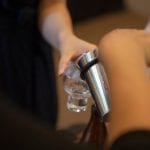 The course will be held from the morning of Tuesday, January 10 to the evening of Saturday, January 14,2017, and will be focused in Tokyo, but with a two- day excursion to the Osaka – Kyoto – Kobe area to visit four sake breweries of various scale. Geared toward professionals, but open to anyone with an interest in sake, this course will begin with the basics, and will provide the environment for a focused, intense, and concerted training period. It will consist of classroom sessions on all things sake-related, followed by relevant tasting sessions, four sake brewery visits, and exposure to countless brands and styles in several settings, both in comparison to other sake, and with food. Participants will stay together at hotels in Tokyo and Osaka. Lectures will take place in a comfortable classroom, and evening meals will be off-site at various sake- related establishments.
The course will be held from the morning of Tuesday, January 10 to the evening of Saturday, January 14,2017, and will be focused in Tokyo, but with a two- day excursion to the Osaka – Kyoto – Kobe area to visit four sake breweries of various scale. Geared toward professionals, but open to anyone with an interest in sake, this course will begin with the basics, and will provide the environment for a focused, intense, and concerted training period. It will consist of classroom sessions on all things sake-related, followed by relevant tasting sessions, four sake brewery visits, and exposure to countless brands and styles in several settings, both in comparison to other sake, and with food. Participants will stay together at hotels in Tokyo and Osaka. Lectures will take place in a comfortable classroom, and evening meals will be off-site at various sake- related establishments. The cost for this five-day educational experience is ¥190,000. This includes all instruction and materials, as well as evening meals with plenty of sake each night. Other meals, transportation to and from as well as within Japan, and hotel are not included in the tuition. To make a reservation or if you have any questions at all, please send an email to John Gauntner at sakeguy@gol.com .
The cost for this five-day educational experience is ¥190,000. This includes all instruction and materials, as well as evening meals with plenty of sake each night. Other meals, transportation to and from as well as within Japan, and hotel are not included in the tuition. To make a reservation or if you have any questions at all, please send an email to John Gauntner at sakeguy@gol.com .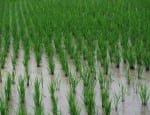
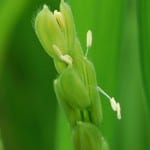
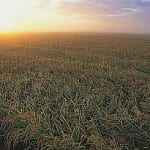
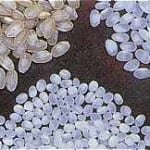
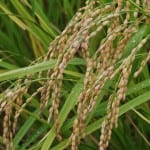
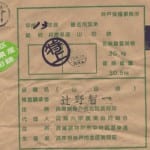

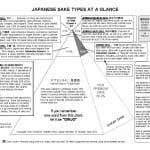

 When sake is made, the first step is milling the rice. In particular for the special sake rice used in making premium sake, milling removes the fat and protein hovering in the outer regions, leaving only the starch in the center of the grains behind. Especially for premium sake, this must be done ever-so-gently, so that the milling process does not crack or break the rice. That would be a bad thing, for many reasons.
When sake is made, the first step is milling the rice. In particular for the special sake rice used in making premium sake, milling removes the fat and protein hovering in the outer regions, leaving only the starch in the center of the grains behind. Especially for premium sake, this must be done ever-so-gently, so that the milling process does not crack or break the rice. That would be a bad thing, for many reasons.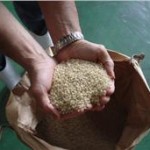
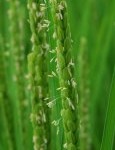

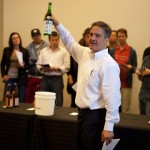

 In part, the toji system came about with a little help from the government. In 1798 the Shogunate formalized an economic system based on rice. In order to establish tight control, the government decreed that no sake brewing was permitted before the Autumn Equinox. Although not much could be done in the warmer seasons anyway, sake brewers now had to go into the boonies to get the farmers who found themselves with too much free time in the winter.
In part, the toji system came about with a little help from the government. In 1798 the Shogunate formalized an economic system based on rice. In order to establish tight control, the government decreed that no sake brewing was permitted before the Autumn Equinox. Although not much could be done in the warmer seasons anyway, sake brewers now had to go into the boonies to get the farmers who found themselves with too much free time in the winter. The various toji schools are usually centered in the snowy regions of Japan, like the northern Tohoku region and Hokuriku region. Although the dekasegi system of travelling far from home for seasonal work was never limited to the sake brewing industry, the pay and status of sake laborers was always relatively higher than other seasonal labor jobs. In general, the competition for jobs in the sake industry has thus been more intense than in other industries employing dekasegi laborers. For more on toji schools, click here.
The various toji schools are usually centered in the snowy regions of Japan, like the northern Tohoku region and Hokuriku region. Although the dekasegi system of travelling far from home for seasonal work was never limited to the sake brewing industry, the pay and status of sake laborers was always relatively higher than other seasonal labor jobs. In general, the competition for jobs in the sake industry has thus been more intense than in other industries employing dekasegi laborers. For more on toji schools, click here.
 Next, toji check the status of the various tanks of fermenting sake mash. This mash, called moromi in Japanese, is a mixture of koji, rice, water, and yeast. The mash must undergo fermentation to yield alcohol, and the typical fermentation period lasts two to three weeks. However, premium ginjo-shu sake takes longer (usually one month) to ferment.
Next, toji check the status of the various tanks of fermenting sake mash. This mash, called moromi in Japanese, is a mixture of koji, rice, water, and yeast. The mash must undergo fermentation to yield alcohol, and the typical fermentation period lasts two to three weeks. However, premium ginjo-shu sake takes longer (usually one month) to ferment. eyes to judge the condition of the mash. He looks at the foam on the surface of the moromi, how much carbon dioxide is emanating from it, the amount and appearance of the foam, and even the sound of the foam as it churns and bubbles pop. The toji call this “talking to the moromi.” It ‘s like judging a baby’s health by listening to the baby’s crying. Then, based on this information, adjustments are made.
eyes to judge the condition of the mash. He looks at the foam on the surface of the moromi, how much carbon dioxide is emanating from it, the amount and appearance of the foam, and even the sound of the foam as it churns and bubbles pop. The toji call this “talking to the moromi.” It ‘s like judging a baby’s health by listening to the baby’s crying. Then, based on this information, adjustments are made. After checking on the moromi and koji, the toji eat breakfast. Following that, preparations are made for the sake that will be brewed that day. This includes washing rice, steaming large amounts of rice, cooling the rice after steaming, adding it to the correct fermenting tanks, and making koji.
After checking on the moromi and koji, the toji eat breakfast. Following that, preparations are made for the sake that will be brewed that day. This includes washing rice, steaming large amounts of rice, cooling the rice after steaming, adding it to the correct fermenting tanks, and making koji.
